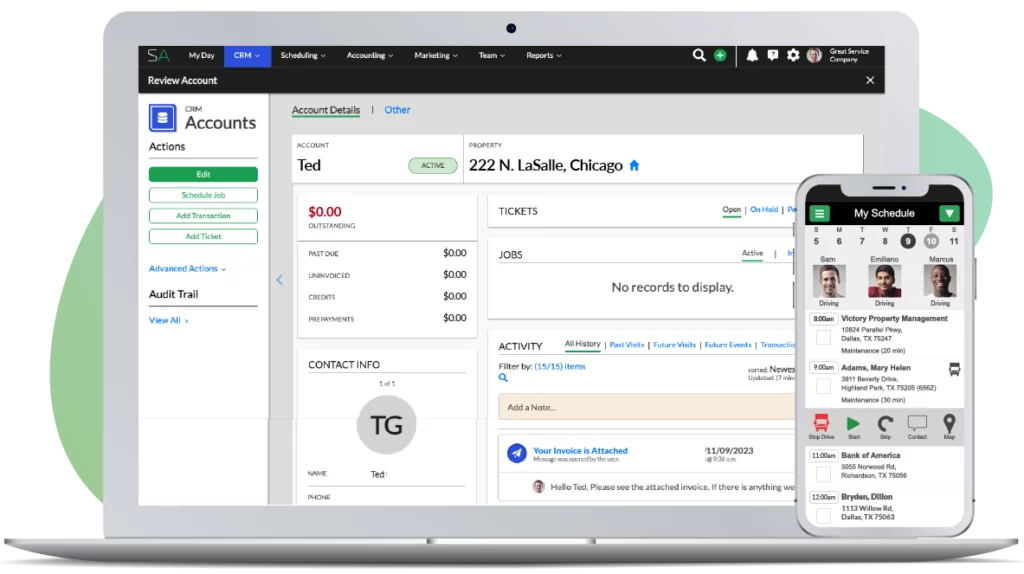Watch this video and learn from Jonathan’s experience what size lawn crew to use and why.
What size lawn crew do you use and why have you always done it that way?
To answer the question, it’s important to know that we’re about 95% residential and 5% commercial. We started as commercial and shifted to residential. Along the way, we have tried all kinds of different crew sizes. It’s also important to know that we know who our ideal client is and what the size of their property is. We only go after the kind of client that is our ideal and we ignore everything else in our market.
We have everything in our market from small commercial to very large commercial; from very small residential, 7,000 gross square feet and less, all the way up to multi-acre residential properties and estates. It’s also critical to understand that what we have found best works for us, and it’s different for every company, is that each tech and each crew are charged with their own activity.
Mowing crews mow, trimming crews trim, spray techs spray, pest control does pest control, irrigators do irrigation. They don’t cross over. They’re trained in their area of expertise. That’s really important to know. When we go mow, we send our mowing teams in. And, when it’s time to prune the brushes or shrubs, a different crew comes in. There are some efficiencies lost from doing it that way, but we believe from testing and trying things that there are huge efficiencies gained. That’s important to understand to understand my answer.
For residential mowing crews, the ideal for us is three based on property size. We have tried four and we didn’t gain much. We’ve run four at times when we’re in what I’d describe as an emergency due to weather. You do get more done, but the efficiency isn’t there and your per man hour, your hourly man rate comes down. We have also tested two. Two is actually more efficient than three for smaller residential, but then you get into a new issue and that is asset utilization…trucks, equipment and such. Then you have insurance and safety risk, opportunity costs, and all these other factors to consider.
For us, at this size, three is better than two because of management, the way we pay, and all these other factors. If I was starting over and I was a small business again, then two is what I would run. I would run two man mowing crews. Again, you have to understand what kind of business we are and what market we’re serving and know that we go after the clients that we want, not the properties that are available to us. We are able to say we want properties of this size and not properties of another size. If our crews had to maintain acreage, one acre plus properties, and then they spend the other half of their day mowing properties under 15,000 square feet, the business wouldn’t work out so well.
If our irrigators had to do certain activities for one half of the day and a different activity for the rest of the day, that would completely change the decisions that we make. We’ve not always done it this way. We started out as commercial. On most of our original commercial accounts we were running four man crews. Then we realized that it made more sense on our warehouse properties that required a different service level to just run a two man crew.
We had a Scag, maybe a 61 inch rider, a 21 inch mower, a couple of weed eaters, and we realized that it’s more efficient to take some equipment off the truck and send just two men out to do this. On our bigger commercial properties we have found four man crews made more sense. We never did commercial properties that took more than a full day. Our biggest properties would be a one day job with four men on the job.
It’s a different animal when you are dealing with commercial properties that could require 16 to 20 people on the job site. That’s not what I’m talking about. We tend to cater more towards the smaller properties. As a result, our crew size can be smaller.
For bush trimming, we’ve tested everything from two men all the way to four men. Two without question generates the most production, the most profitability. Production was the wrong word to use, you can get more pure production of four people versus two, but when you look at what matters, which is how much money you’re generating per man hour, two is more efficient. Sometimes we have to sacrifice the margin to get all the work done and add a third person, but at the end of the day, two is more efficient.
That’s not where we started. That was a realization in the last three years or so, and that’s where we’re at now.
For spray techs, commercial or residential, it depends. When you are out spraying commercial properties, pulling a lot of hose, it oftentimes makes sense to put two men on that job. When you’re doing small residential, one man is perfectly acceptable as a spray tech. The same is with pest control. Irrigation oftentimes we find that one man makes perfect sense, but for many reasons a lot of times, we run a two man team for irrigation. Again, it depends on if are we doing commercial or residential, what’s going on, what’s happening, and what’s our backlog? Backlog has a lot to do with how big the crew is that we’re running right now.
In a perfect world, we would have completely consistent demand, meaning that our backlog would never grow too large. That would allow us to constantly maintain that sweet spot of profit margin, meaning that we’re running the perfect crew size. But at times we are forced to go against what we know is best and add an additional person to an irrigation crew, to a lawn care crew, to a maintenance crew, just because we have to deal with demand. We have to keep our level of customer service.
Profit is sacrificed a bit, but we continue to maintain our reputation and continue to maintain the level of customer service that we’ve promised our clients. These are example considerations. And yes, it has absolutely evolved over the years, and it will continue to evolve as our company continues to evolve.



